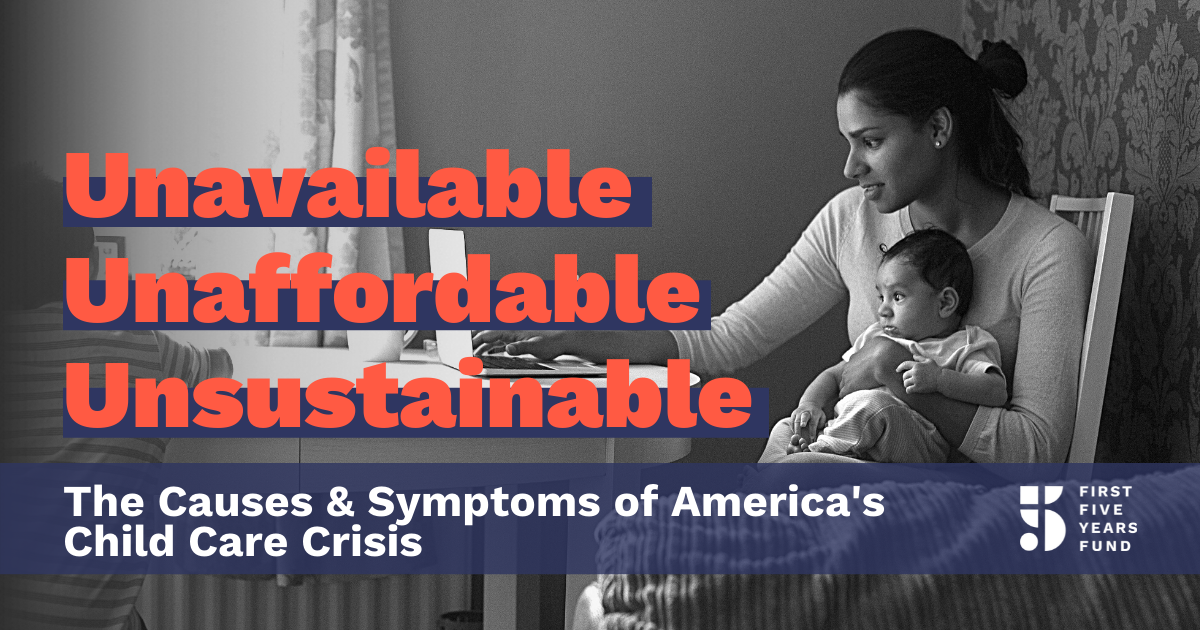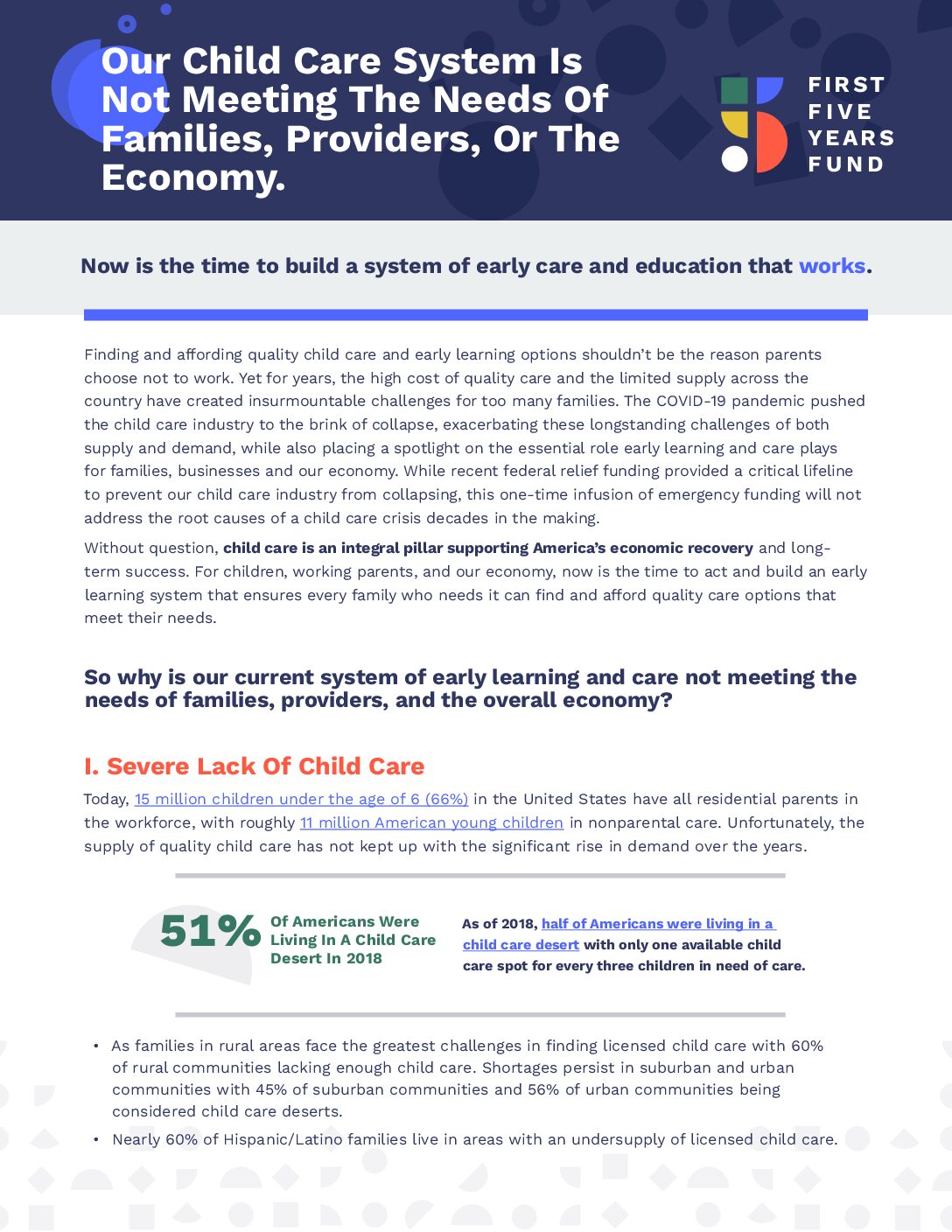Our Child Care System Is Not Meeting The Needs Of Families, Providers, or The Economy

Now is the time to build a system of early care and education that works.
Finding and affording quality child care and early learning options shouldn’t be the reason parents choose not to work. Yet for years, the high cost of quality care and the limited supply across the country have created insurmountable challenges for too many families. The COVID-19 pandemic pushed the child care industry to the brink of collapse, exacerbating these longstanding challenges of both supply and demand, while also placing a spotlight on the essential role early learning and care plays for families, businesses and our economy.
Without question, child care is an integral pillar supporting America’s economic recovery and long- term success. For children, working parents, and our economy, now is the time to act and build an early learning system that ensures every family who needs it can find and afford quality care options that meet their needs.
So why is our current system of early learning and care not meeting the needs of families, providers, and the overall economy?
I. Severe Lack Of Child Care
Today, 15 million children under the age of 6 (66%) in the United States have all residential parents in the workforce, with roughly 11 million American young children in non-parental care. Unfortunately, the supply of quality child care has not kept up with the significant rise in demand over the years.
- As of 2018, half of Americans were living in a child care desert with only one available child care spot for every three children in need of care.
- As families in rural areas face the greatest challenges in finding licensed child care with 60% of rural communities lacking enough child care. Shortages persist in suburban and urban communities with 45% of suburban communities and 56% of urban communities being considered child care deserts.
- Nearly 60% of Hispanic/Latino families live in areas with an undersupply of licensed child care.
II. Families Can’t Afford The Care They Find
Even where child care is available, the cost is more than what most families can afford. Child care costs often exceed other essential costs of living, including housing and transportation, putting many low- and middle-income families in the position of not being able to work because they can’t afford care.
- The price of child care has increased by 25% in the last decade, with the average annual price of care in 2018 at roughly $10,000. This means that on average, two-income families spend 15% of their income on child care, and in single-parent households, 36% of parent income goes to child care.
- 83% of parents with children under age 5 say that finding affordable care is a challenge. 63% of full-time working parents have a hard time paying for market-price full-time care, and for low- income parents, that percentage balloons to 95%.
- In 40 states and the District of Columbia, child care costs for two children exceed average mortgage costs.
- In 2019, 72% of parents who did not intend to have a child in the future because of financial reasons said child care costs significantly influenced their decision.
III. The Current System Of Financing Child Care Forces Families And Providers To Make Tough Choices
During the COVID-19 pandemic, American families learned quickly and acutely that early education and care providers operate on razor-thin margins when many providers shuttered due to insolvency. As a market-based system, the labor-intensive nature of caring for infants, toddlers, and preschoolers means that it costs more for providers to deliver quality child care than families can afford. Well- qualified early childhood educators are a vital component to providing high-quality early learning and care opportunities for children from birth through age five. To remain solvent, much less profitable, early learning programs must often resort to offering lower compensation for child care workers and staff in order to cover high fixed costs and avoid compromising safety and quality for children. These stark financial realities have also complicated efforts to rehire and retrain providers as our economy continues to open back up.
- Low wages and insufficient benefits lead to turnover rates as high as 40% in the early care and education industry.
- An estimated 160,000 openings for child care workers is projected each year over the next decade due to retirements or changing occupations.
- Prior to the pandemic, there were 1.1 million people employed in the child care sector, with a median annual income of only $24,230, around $11.65 per hour.
- The early care and education sector is comprised almost exclusively (90%) of women, 40% of whom are people of color. Early educators of color are more likely to be at the lower end of the wage continuum, even when controlling for education level.
IV. Child Care Is Key To A Robust Economy
The inability to access care significantly impacts our economy as a whole. Parents’ inability to access and afford child care causes higher rates of employee absence, turnover, postponement of education or training opportunities, reduction of working hours, and working parents leaving the workforce.
- The annual economic losses due to lack of child care ranges from $500 million to $3.5 billion in each state.
- Parents lose about $30-35 billion in income as they reduce working hours or leave the workforce given unaffordable early care and education costs.
- A lack of child care causes businesses to lose an estimated $4.4 billion annually due to employee absenteeism.
- Reliable access to child care can generate an additional $79,000 in lifetime earnings for mothers. What’s more, single mothers who receive assistance for child care payments are nearly 40% more likely to maintain employment over two years than those who do not.
- According to the U.S. Chamber of Commerce Foundation, states miss out on hundreds of millions, if not billions of dollars each year in economic activity due to breakdowns in child care.
V. The Pandemic Has Only Made the Situation Worse
The COVID-19 pandemic caused the child care industry to face stark realities of increased costs to implement new health and safety requirements and decreased revenue due to limited enrollment and capacity. This led to a majority of providers losing money every day they remained open, and many closing their doors permanently, leaving parents with even less options than before. Like so many other industries impacted by the pandemic, recovery will not happen overnight; it will take time for the child care sector to get back on its feet. But given current trends with early educators leaving the industry entirely, recovery is likely to be more of a challenge in child care.
- According to the Bureau of Labor Statistics, the child care industry lost roughly 134,500 jobs between February 2020 and May 2021 which still have not been recovered.
- As of December 2020, an average of 10% of child care centers and family child care homes remained closed.
- In just fifteen states that are tracking permanent child care closures, a total of 682 centers and 1,032 family child care programs have closed permanently during the COVID-19 pandemic. The number of closures is expected to go up as more states make their own assessments.
The American Rescue Plan Act provided critical relief to a child care industry that would have collapsed without an infusion of emergency funding provided by Congress and the administration; however, as intended, relief funding is merely ensuring the current child care system simply survives. While survival of the industry is paramount, federal relief dollars will not address long standing challenges in a system that is struggling to meet the needs of parents, providers, and businesses.
Now is the Time to Build a Child Care System that Works
As our country gets back on track and we look to build a robust economy for the future, Congress must invest in children, families, providers, and our economy by creating a system of early learning and care that works for those who need it. To ensure working parents have options that meet their needs, additional federal investments are needed to address the longstanding challenges of the supply, affordability, quality and financing of our early learning and child care system. Without long- term robust federal investments, our current inadequate system of care will continue to not meet the needs of the families and businesses that rely on it, holding back our nation’s long-term economic growth. Congress must pass comprehensive solutions addressing the continuum of care and education for children from birth through age 5 that provide the following:
- Ensure families have access to high-quality, affordable child care that is available when and where they need it, regardless of where they live.
- Caregivers and early childhood educators should be treated with respect and dignity, and compensated for their valuable and complex work.
- Provide equitable access to preschool in a mixed delivery model that is part of a robust birth through five system, strengthening existing high-quality programs or creating new ones where they don’t exist.
- Support safe, energy-efficient, developmentally appropriate child care facilities, especially in child care deserts.
Subscribe to FFYF First Look
Every morning, FFYF reports on the latest child care & early learning news from across the country. Subscribe and take 5 minutes to know what's happening in early childhood education.




